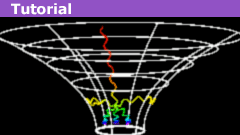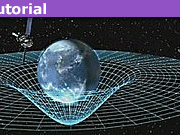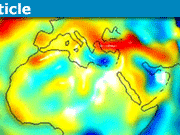The Schwarzschild Geometry: Key Properties
Not long after Einstein published his Field Equation, the first exact solution was found by Karl Schwarzschild. This solution is one of the best known and most often discussed, and its properties have played a significant role in the development of General Relativity as a theory, as well as in efforts to find a theory of quantum gravity. It has also given rise to many misconceptions, and one of my reasons for writing this article series is to provide a good quick reference to help dispel those misconceptions.
In this series of articles, I am going to discuss the key properties of the spacetime geometry described by Schwarzschild’s solution, according to our best current modern understanding. Along the way, I am also going to talk about how that understanding developed and about some of the misconceptions that arose and were later corrected as part of that process of development. I am not going to go into detail about how the solution was derived; if you are interested in that, I give a quick derivation as part of my Insights article about Birkhoff’s Theorem. I am also not going to derive in detail the other equations I give; I encourage you to confirm those equations by deriving them yourself. (In addition to the metric, it will be useful to have the geodesic equation for radial free fall and for circular free-fall orbits; the easiest formulation of that is in terms of an effective potential, as discussed in most GR textbooks.)
To start off, let’s write down the metric of Schwarzschild’s solution, in the most common coordinates used to describe it, which are called Schwarzschild coordinates even though they aren’t quite the ones that Schwarzschild himself used:
$$
ds^2 = – \left( 1 – \frac{2M}{r} \right) dt^2 + \frac{1}{1 – \frac{2M}{r}} dr^2 + r^2 \left( d\theta^2 + \sin^2 \theta d\phi^2 \right)
$$
(I am using units in which ##G = c = 1##.)
GR textbooks rightly stress the fact that coordinates in themselves have no physical meaning; but if we are careful, we can still tell quite a bit about a spacetime by looking at the expression for its metric in a particular set of coordinates, if the coordinates are well chosen. In this case, we can read off some key properties of the Schwarzschild geometry from the above metric:
(1) The metric coefficients are all independent of the coordinate ##t##. That means that the vector field ##\partial / \partial t## is what is called a Killing vector field; along integral curves of this vector field, the local geometry of the spacetime does not change. (It is tempting since ##t## is usually called the “time” coordinate, to say that the geometry “does not change with time”; but we will resist this temptation for now for reasons which will become apparent later on.)
(2) The metric is diagonal. That means, first, that hypersurfaces of constant ##t## are orthogonal to the integral curves of the Killing vector field ##\partial / \partial t##, and second, that within each of these hypersurfaces, the coordinate basis vectors ##\partial / \partial r##, ##\partial / \partial \theta##, and ##\partial / \partial \phi## are all orthogonal. The first property is referred to as the spacetime being “hypersurface orthogonal”–that is, there is a set of hypersurfaces that is everywhere orthogonal to a particular vector field. The second does not have an explicit name that I know of, but is also important, as the next item will show.
(3) The last two terms are just the standard metric on a 2-sphere using standard angular coordinates. That means this spacetime is spherically symmetric–the entire spacetime is an infinite family of 2-spheres, and each 2-sphere is labeled by a unique pair of values for the coordinates ##t## and ##r##. The latter part follows from #2 above, that the tangent vectors on each 2-sphere are orthogonal to the vector fields ##\partial / \partial t## and ##\partial / \partial r##. This is very helpful because it means that for many purposes (including most of what we will discuss here) we can ignore the ##\theta## and ##\phi## coordinates and concentrate on ##t## and ##r## only.
(4) The physical area of a given 2-sphere is ##4 \pi r^2##, where ##r## is the value of the radial coordinate that labels the 2-sphere. This is in fact a way of stating how the coordinate ##r## is defined in this coordinate chart.
Let’s now focus on the constant ##M## that appears in the metric. What does it mean, physically? Of course, we know that ##M## is called the “mass”, but we also know that this solution is a vacuum solution, so there is no matter or energy anywhere; so what is this “mass” the mass of?
We can investigate this by considering an observer who is following a worldline of constant ##r## (and ##\theta## and ##\phi##). We will assume that ##r > 2M##, since it is evident from the metric that this is required for the worldline in question to be timelike (i.e., for the interval ##ds^2## to be less than zero given that ##dt^2## is the only nonzero coordinate differential). What is the proper acceleration of this observer? It is easily computed to be:
$$
a = \frac{M}{r^2 \sqrt{1 – \frac{2M}{r}}}
$$
For ##r >> 2M##, this reduces to ##M / r^2##, which is just the Newtonian proper acceleration of an object that is “hovering” at a constant radius above a gravitating body with mass ##M##. We can confirm the interpretation of ##M## that this suggests by looking at another observer, one who is in a free-fall circular orbit with constant ##r## and ##\theta##; it is easy to show that the coordinate time it takes for such an observer to complete one orbit is:
$$
T = 2 \pi \sqrt{\frac{r^3}{M}}
$$
which should be recognizable as Kepler’s Third Law for an object in a circular Newtonian orbit of radius ##r## around a mass ##M##.
So ##M## appears to have the physical interpretation of “mass”, but this “mass” is a property of the spacetime geometry, not of any “object”–no matter or energy. So now we wonder: what happens to an object that falls radially in this spacetime geometry? If there were an ordinary gravitating body there, like a planet or star, a radially falling object would hit its surface; but there is no ordinary gravitating body there. So what happens?
Let’s first look at the equation for ##dr / dt## for a body that is freely falling radially inward, starting from rest at infinity. This equation is:
$$
\frac{dr}{dt} = – \left( 1 – \frac{2M}{r} \right) \sqrt{\frac{2M}{r}}
$$
For ##r \rightarrow \infty##, this goes to zero, which is consistent with our initial condition of “at rest at infinity”. As ##r## decreases from very large values, ##dr / dt## increases for a while; but then it starts decreasing again, and approaches zero once more as ##r \rightarrow 2M##.
We have just run up against one of the main misconceptions about Schwarzschild spacetime. This behavior of ##dr / dt## seems to tell us that the infalling object slows down as it approaches ##r = 2M##, and never quite reaches that point (it is easily shown that ##r > 2M## for any finite ##t##). Many physicists in the first few decades after the Schwarzschild solution was discovered attributed this apparent behavior to gravitational time dilation. However, the behavior is only apparent. The quantity ##dr / dt## is a coordinate speed; in itself, it has no physical meaning. If we want to extract physical meaning from it, we need to relate it to some invariant–some quantity that doesn’t depend on the coordinates. We did that above when we enumerated our properties #1, #2, #3, and #4; in each case, we found an invariant feature of the geometry (Killing vector fields, orthogonality, etc.) that corresponded to the coordinate property in question. So what is the relevant invariant now?
There is one obvious invariant for the infalling object: the quantity ##dr / d\tau##, the rate of change of ##r## with respect to the infalling object’s own proper time. Note that this is in fact an invariant because ##r##, even though it appears as a coordinate in the chart we are using, has an invariant geometric interpretation in terms of the physical area of 2-spheres (our fourth property above). So ##dr / d\tau## is telling us how fast the areas of 2-spheres the object is falling past decrease, with respect to the object’s own clock.
The equation for ##dr / d\tau## is even simpler; it is just
$$
\frac{dr}{d\tau} = – \sqrt{\frac{2M}{r}}
$$
This does not go to zero as ##r \rightarrow 2M##; instead, it is equal to ##- 1## at that point (the minus sign is because the object is falling inward), and continues to increase in magnitude (i.e., get more negative) as ##r## decreases. So as far as the infalling object is concerned, it keeps on falling right through ##r = 2M## (or equivalently through the 2-sphere with physical area ##16 \pi M^2##) and on to smaller 2-spheres.
What is going on here? We have two seemingly contradictory predictions: the equation for ##dr / dt## is telling us that an infalling object slows down more and more and never quite reaches ##r = 2M##; while the equation for ##dr / d\tau## is telling us that the object continues to speed up as it falls, and goes right through ##r = 2M## and beyond. Which one is right?
We have one other indication that we haven’t talked about yet: the metric in the coordinates we have been using behaves strangely at ##r = 2M##. The coefficient of ##dt^2## goes to zero, and the coefficient of ##dr^2## is undefined. This raises the suspicion that the behavior of ##dr / dt## as ##r \rightarrow 2M## might be an artifact of the coordinates. What we would like to do is find a coordinate transformation that removes at least some of the strange behavior at ##r = 2M##. Fortunately, there is one, first discovered as long ago as 1921-2, but its full implications were not widely recognized until much later. These coordinates are called Gullstrand-Painleve coordinates, after two physicists who independently discovered them.
The idea is to try to rescale the time coordinate so that it reflects the proper time of the radially infalling object. The transformation that does that is:
$$
T = t – 2M \left[ – 2 \sqrt{\frac{r}{2M}} + \ln \left( \frac{\sqrt{\frac{r}{2M}} + 1}{\sqrt{\frac{r}{2M}} – 1} \right) \right]
$$
The metric that results is:
$$
ds^2 = – \left( 1 – \frac{2M}{r} \right) dT^2 + 2 \sqrt{\frac{2M}{r}} dT dr + dr^2 + r^2 \left( d\theta^2 + \sin^2 \theta d\phi^2 \right)
$$
It is easily shown that the coordinate speed ##dr / dT## of an object free-falling radially inward from rest at infinity is now ##- \sqrt{2M/r}##, as we desired–i.e,. that the time coordinate ##T## in this chart now directly reflects the proper time of such infalling objects. So the behavior of ##dr / dt## in Schwarzschild coordinates as ##r \rightarrow 2M## was in fact an artifact of the coordinates and was not telling us anything physical.
To rephrase this last statement: the radially free-falling object does reach and go beyond ##r = 2M##. The behavior of ##dr / dt## in Schwarzschild coordinates is not telling us about the object; it’s telling us about the coordinates–that they become highly distorted as we get close to ##r = 2M##, to the point of “infinite distortion” exactly at ##r = 2M##. Notice that the coordinate transformation that takes us from Schwarzschild coordinates to Gullstrand-Painleve coordinates is itself singular at ##r = 2M##. That is because of the distortion of Schwarzschild coordinates. (In the next article, when we look at still other coordinate charts, we will find a way to actually visualize this distortion.) It is the quantity ##dr / d\tau##, or ##dr / dT## in Gullstrand-Painleve coordinates, that is telling us about the infalling object itself.
But we’re not done; the metric in Gullstrand-Painleve coordinates still has the property that the coefficient of ##dT^2## goes to zero at ##r = 2M##. In other words, the vector field ##\partial / \partial T##, like the vector field ##\partial / \partial t## in Schwarzschild coordinates, is no longer timelike at ##r = 2M##. (In fact, these are the same vector field, just described in different coordinates.) Also, the radial speed ##dr / d\tau## of the infalling object (which is also its coordinate speed ##dr / dT## in Gullstrand-Painleve coordinates) has magnitude ##1## at ##r = 2M##, and still larger magnitude for ##r < 2M##; but magnitude ##1## is the speed of light in the units we are using. Does that mean the infalling object can go as fast as, or faster than, light? If not, what do those magnitudes mean?
So we still have more investigating to do. We’ll continue that in the next article.
- Completed Educational Background: MIT Master’s
- Favorite Area of Science: Relativity








Leave a Reply
Want to join the discussion?Feel free to contribute!